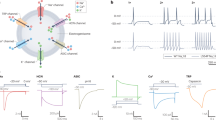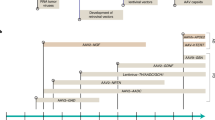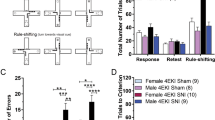Abstract
Traditional approaches to treating chronic neuropathic pain largely focus on manipulations directly altering neuronal activity or neuron-to-neuron communication. Recently, however, it has become clear that glial cells (including microglia and astroglia) play a significant role in pain expression in a variety of neuropathic pain models. Multiple aspects of the inflammatory response of glial cells, commonly observed in neuropathic pain conditions, have been implicated in pain expression. Thus, glial cell inflammation has emerged as a potential therapeutic target in neuropathic pain. Our laboratory has been exploring the use of an anti-inflammatory cytokine, interleukin-10 (IL-10), to control glial inflammatory activation thereby controlling neuropathic pain. IL-10 protein delivery is limited by a short half-life and an inability to cross into the central nervous system from the periphery, making a centrally delivered gene therapy approach attractive. We have recently characterized a non-viral gene therapy approach using two injections of naked DNA to achieve long-term (>3 months) control of neuropathic pain in a peripheral nerve injury model. Timing and dose requirements leading to long-term pain control are discussed in this review, as is recent work using microparticle-encapsulated DNA to achieve long-term therapeutic efficacy with a single injection.
This is a preview of subscription content, access via your institution
Access options
Subscribe to this journal
Receive 12 print issues and online access
$259.00 per year
only $21.58 per issue
Buy this article
- Purchase on Springer Link
- Instant access to full article PDF
Prices may be subject to local taxes which are calculated during checkout




Similar content being viewed by others
References
Macleod M, Stewart G, Zeidler M, Will R, Knight R . Sensory features of variant Creutzfeldt-Jakob disease. J Neurol 2002; 249: 706–711.
Osterberg A, Boivie J, Thuomas K . Central pain in multiple sclerosis—prevalence and clinical characteristics. Eur J Pain 2005; 9: 531–542.
Kenner M, Menon U, Elliott D . Multiple Sclerosis as a painful disease. Int Rev Neurobiol 2007; 79: 303–321.
Jensen M, Kuehn C, Amtmann D, Cardenas D . Symptom burden in persons with spinal cord injury. Arch Phys Med Rehab 2007; 88: 638–645.
Rowbotham M, Fields H . The relationship of pain, allodynia, and thermal sensation in post-herpetic neuralgia. Brain 1996; 119: 347–354.
Milligan E, Twinning C, Chacur M, Biedenkapp J, O’Connor K, Poole S et al. Spinal glia and proinflammatory cytokines mediate mirror-image neuropathic pain in rats. J Neurosci 2003; 23: 1026–1040.
Watkins L, Milligan E, Maier S . Glial proinflammatory cytokines mediate exaggerated pain states: implications for clinical pain. Adv Exp Med Biol 2003; 521: 1–21.
Tsuda M, Inoue K, Salter M . Neuropathic pain and spinal microglia: a big problem from molecules in ‘small’ glia. Trends Neurosci 2005; 28: 101–107.
McMahon S, Cafferty W, Marchand F . Immune and glial cell factors as pain mediators and modulators. Exp Neurol 2005; 192: 444–462.
DeLeo J, Tawfik V, LaCroix-Fralish M . The tetrapartite synapse: path to CNS sensitization and chronic pain. Pain 2006; 122: 17–21.
Benveniste E . Cytokines: influence on glial cell gene expression and function. Neuroimmunoendocrinology 1997; 69: 31–75.
Milligan E, Sloane E, Watkins L . Glia in pathological pain: a role for fractalkine. J Neuroimmunol 2008; 198: 113–120.
Araque A, Perea G . Glial modulation of synaptic transmission in culture. Glia 2004; 47: 241–248.
Ren K, Dubner R . Neuron-glia crosstalk gets serious: role in pain hypersensitivity. Curr Opin Anaesthesiol 2008; 21: 570–579.
Sun X, Chen W, Li S, Cai J, Li W, Xian X et al. Fluorocitrate, an inhibitor of glial metabolism, inhibits the up-regulation of NOS expression, activity and NO production in the spinal cord induced by formalin test in rats. Neurochem Res 2009; 34: 351–359.
Holguin A, O’Connor K, Biedenkapp J, Campisi J, Wieseler-Frank J, Milligan E et al. HIV-1 gp120 stimulates proinflammatory cytokine-mediated pain facilitation via activation of nitric oxide synthase-1 (nNOS). Pain 2004; 110: 517–530.
Viviani B, Bartesaghi S, Gardoni F, Vezzani A, Behrens M, Bartfai T et al. Interleukin-1beta enhances NMDA receptor-mediated intracellular calcium increase through activation of the Src family of kinases. J Neurosci 2003; 23: 8692–8700.
Gong Q, Li Y, Xin W, Zang Y, Ren W, Wei X et al. ATP induces long-term potentiation of C-fiber-evoked field potentials in spinal dorsal horn: the roles of P2X(4) receptors and p38 MAPK in microglia. Glia 2008; doi:10.1002/glia.20786.
Jabs R, Seifert G, Steinhauser C . Astrocytic function and its alteration in the epileptic brain. Epilepsia 2008; 49: 3–12.
Xing G, Liu F, Qu X, Han J, Wan Y . Long-term synaptic plasticity in the spinal dorsal horn and its modulation by electroacupunture in rats with neuropathic pain. Exp Neurol 2007; 208: 323–332.
Gwak Y, Kang J, Leem J, Hulsebosch C . Spinal AMPA receptor inhibition attenuates mechanical allodynia and neuronal hyperexcitability following spinal cord injury in rats. J Neurosci Res 2007; 85: 2352–2359.
Waxman S, Hains B . Fire and phantoms after spinal cord injury: Na+ channels and central pain. Trends Neurosci 2006; 29: 207–215.
Ledeboer A, Breve J, Poole S, Tilders F, Dam AV . Interleukin-10, interleukin-4, and transforming growth factor-beta differentially regulate lipopolysaccharide-induced production of pro-inflammatory cytokines and nitric oxide in co-cultures of rat astroglial and microglial cells. Glia 2000; 30: 134–142.
Strle K, Zhou J, Shen W, Broussard S, Johnson R, Freund G et al. Interleukin-10 in the brain. Crit Rev Immunol 2001; 21: 427–449.
Marques CP, Hu S, Sheng W, Cheeran MC-J, Cox D, Lokensgard JR . Interleukin-10 attenuates production of HSV-induced inflammatory mediators by human microglia. Glia 2004; 47: 358–366.
Moore K, Malefyt R, Coffman R, O’Garra A . Interleukin-10 and the interleukin-10 receptor. Annu Rev Immunol 2001; 19: 683–765.
Plunkett J, Yu C, Easton J, Bethea J, Yezierski R . Effects of interleukin-10 (IL-10) on pain behavior and gene expression following excitotoxic spinal cord injury in the rat. Exp Neurol 2001; 168: 144–154.
Schif-Zuck S, Wildbaum G, Karin N . Coadministration of plasmid DNA constructs encoding an encephalitogenic determinant and IL-10 elicits regulatory T cell-mediated protective immunity in the central nervous system. J Immunol 2006; 177: 8241–8247.
Milligan E, Soderquist R, Malone S, Mahoney J, Hughes T, Langer S et al. Intrathecal polymer-based interleukin-10 gene delivery for neuropathic pain. Neuron Glia Biology 2006; 2: 293–308.
Sloane E, Ledeboer A, Seibert W, Coats B, van Strien M, Maier S et al. Anti-inflammatory cytokine gene therapy decreases sensory and motor dysfunction in experimental Multiple Sclerosis. Brain Behav Immun 2009; 23: 92–100.
Ledeboer A, Wierinckx A, Bol J, Floris S, de Lavalette R, de Vries H et al. Regional and temporal expression patterns of interleukin-10, interleukin-10 receptor and adhesion molecules in the rat spinal cord during chronic relapsing EAE. J Neuroimmunol 2003; 136: 94–103.
Milligan E, Langer S, Sloane E, He L, Wieseler-Frank J, O’Connor K et al. Controlling pathological pain by adenovirally driven spinal production of the anti-inflammatroy cytokine, interleukin-10. Eur J Neurosci 2005; 21: 2136–2148.
Storek B, Reinhardt M, Wang C, Janssen W, Harder N, Banck M et al. Sensory neuron targeting by self-complementary AAV8 via lumbar puncture for chronic pain. PNAS 2008; 105: 1055–1060.
Zhou Z, Peng X, Hao S, Fink D, Mata M . HSV-mediated transfer of interleukin-10 reduces inflammatory pain through modulation of membrane tumor necrosis factor α in spinal cord microglia. Gene Therapy 2008; 15: 183–190.
Milligan E, Sloane E, Langer S, Cruz P, Chacur M, Spataro L et al. Controlling neuropathic pain by adeno-associated virus driven production of the anti-inflammatory cytokine, interleukin-10. Mol Pain 2005; 1: 9; doi:10.1186/1744-8069-1181-1189.
Driesse M, Esandi M, Kros J, Avezaat C, Vecht C, Zurcher C et al. Intra-CSF administered recombinant adenovirus causes an immune response-mediated toxicity. Gene Therapy 2000; 7: 1401–1409.
Zaiss A, Muruve D . Immune responses to adeno-associated virus vectors. Curr Gene Ther 2005; 5: 323–331.
Sloane E, Langer S, Jekich B, Mahoney J, Hughes T, Seibert W et al. Immunological priming potentiates non-viral anti-inflammatory gene therapy treatment of neuropathic pain. In Revision 2008.
Milligan E, Sloane E, Langer S, Hughes T, Jekich B, Frank M et al. Repeated intrathecal injections of plasmid DNA encoding interleukin-10 produce prolonged reversal of neuropathic pain. Pain 2006; 126: 294–308.
Ledboer A, Jekich B, Sloane E, Mahoney J, Langer S, Milligan E et al. Intrathecal interleukin-10 gene therapy attenuates paclitaxel-induced mechanical allodynia and proinflammatory cytokine expression in dorsal root ganglia in rats. Brain Behav Immun 2007; 21: 686–698.
Soderquist R, Sloane E, Harrison J, Loram L, Lewis M, Chavez R et al. Microparticle mediated therapeutic pDNA delivery facilitates long term reversal of neuropathic pain following a single intrathecal administration. In Preparation 2008.
Schwab C, McGeer P . Inflammatory aspects of Alzheimer disease and other neurodegenerative disorders. J Alzheimers Dis 2008; 13: 359–369.
Boillee S, Velde C, Cleveland D . ALS: a disease of motor neurons and their nonneuronal neighbors. Neuron 2006; 52: 39–59.
Zeng H-Y, Green W, Tso M . Microglial activation in human diabetic retinopathy. Arch Ophthalmol 2008; 126: 227–232.
Tsuda M, Ueno H, Kataoka A, Tozaki-Saitoh H, Inoue K . Activation of dorsal horn microglia contributes to diabetes-induced tactile allodynia via extracellular signal-related protein kinase signaling. Glia 2008; 56: 378–386.
Daulhac L, Mallet C, Couteix C, Etienne M, Duroux E, Privat A et al. Diabetes-induced mechanical hyperalgesia involves spinal mitogen-activated protein kinase activation in neurons and microglia via N-Methyl-D-aspartate-dependent mechanisms. Mol Pharmacol 2006; 70: 1246–1254.
Acknowledgements
Financial support to the study was provided by NIH Grants DA018156, DA024044, DA015642, DA015656 and Avigen.
Author information
Authors and Affiliations
Corresponding author
Additional information
This work was conducted at the University of Colorado, Boulder, CO, USA.
Rights and permissions
About this article
Cite this article
Sloane, E., Soderquist, R., Maier, S. et al. Long-term control of neuropathic pain in a non-viral gene therapy paradigm. Gene Ther 16, 470–475 (2009). https://doi.org/10.1038/gt.2009.21
Received:
Revised:
Accepted:
Published:
Issue Date:
DOI: https://doi.org/10.1038/gt.2009.21
Keywords
This article is cited by
-
Anti-nociceptive and anti-inflammatory actions of sulforaphane in chronic constriction injury-induced neuropathic pain mice
Inflammopharmacology (2017)
-
IL-10 and IL-1β Mediate Neuropathic-Pain Like Behavior in the Ventrolateral Orbital Cortex
Neurochemical Research (2015)
-
Improvement of spinal non-viral IL-10gene delivery by D-mannose as a transgene adjuvant to control chronic neuropathic pain
Journal of Neuroinflammation (2014)
-
Emerging targets in neuroinflammation-driven chronic pain
Nature Reviews Drug Discovery (2014)
-
Platelet-Rich Plasma and the Elimination of Neuropathic Pain
Molecular Neurobiology (2013)



